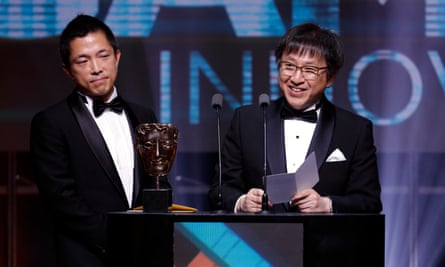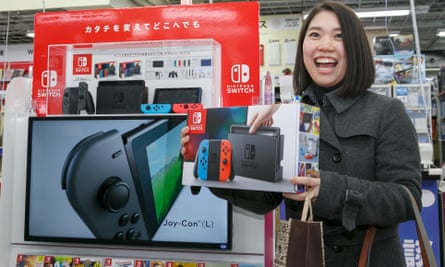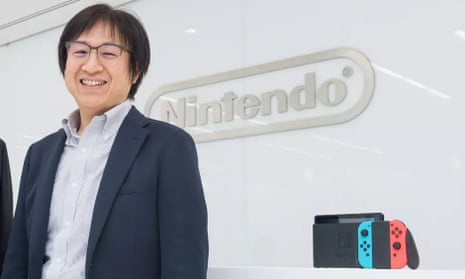Nintendo is coming out of a rough patch in its 128-year history. After spending most of the 00s riding high on the success and profits of its DS and Wii consoles, the current decade has seen the Japanese company struggle to adapt to the changes that its rivals and smartphones have wrought upon the video game world. The death of company president Satoru Iwata in 2015, who presided over a creatively and financially brilliant period in Nintendo’s history, left many wondering how the company would find its way again.
In March 2017, Nintendo’s fortunes turned around again with the launch of the Switch, a smart portable games console that can also be docked next to a TV and played at home. It has proven extremely popular, and its flagship games Mario Odyssey, Splatoon 2 and Zelda: Breath of the Wild hoovered up awards last year, including three Baftas at this month’s ceremony. One of the minds behind this joyful little machine is Shinya Takahashi, Nintendo’s GM of development, who started at the company as an artist in 1989 and is now in charge of Switch. He has been called Nintendo’s conductor.

“People always ask us whether we take risks on purpose. But to us, we don’t really take risks – we just keep trying new things,” said Takahashi last week. Although he has enormous responsibility at Nintendo, he is not a stereotypically stern Japanese executive. His face is warm and affable, his hair slightly scruffy; he is quick to chuckle over both our questions and his own answers. “The thinking that guides us is: what can we do to pleasantly surprise players? It’s not that we’re consciously trying to innovate; we’re trying to find ways to make people happy. The result is that we come up with things other people have not done.”
Takahashi paints innovation as a side-product of Nintendo’s working culture – something about which the company has always been notoriously secretive. In the last few years it has started to open up just a little; its regular Nintendo Direct broadcasts show the faces behind games such as Mario, Zelda, Animal Crossing and Splatoon. In the company’s creative process, explains Takahashi, the ideas come first.
“In many cases, we begin by assigning a small group to a project; not necessarily senior staff, but developers, to try and come up with ideas. Those lead to the end product. Super Mario Odyssey is a good example to explain this: we actually had several small groups and as a result we had many different ideas, which we then put together to make a single product. Naturally during the course of early development, we find the right mission for each project. I believe every game has a different mission. With [Nintendo Switch launch game] 1-2 Switch, for example, the mission was to make a party game where players would not have to look at the screen – where people would face each other.”

A constant flow of new talent is extremely important to this approach. For a long time, the creative face of Nintendo was Shigeru Miyamoto, the creator of Mario – but now there is a newer generation of game creators in the limelight, including Splatoon’s director Tsubasa Sakaguchi, who joined the company in 2004. Nintendo does not prioritise experience in its hiring, says Takahashi – instead it looks for focus.
“The Japanese hiring system is different from western companies. Typically in Japan, we hire people straight out of college,” Takahashi explains. “We have many candidates applying to Nintendo, and in many cases, the ones we hire are the ones who really understand what they have accomplished through their college years. If we see an artist who was very focused and determined about creating a single large-scale project, and they accomplished this over many years, or if we see a person who worked on a single movie from the beginning to the end of their course – that type of person needs a lot of determination and knowledge to accomplish such a thing. That’s what we’re looking for.
“The bottom line is, the quality of the end product that those students created doesn’t really matter to me. How they kept their focus, what they thought throughout those years … that’s what important to me. We like our staff members to be as creative as possible – and creative people should not just listen to their bosses saying ‘Yes sir’, or ‘Yes ma’am’. I want them to always ask themselves, ‘Is this direction correct?’”
The history of Nintendo is one of eccentric ideas. It has pioneered touchscreens, virtual reality, analogue control sticks, motion control, portable games consoles, second screens and wireless controllers – sometimes successfully, sometimes not. Unusual features of Nintendo’s consoles are often what inspire and enable unusual innovations in its games. Often, technology feels strangely distant from the creative things that it enables; the language of technology, of CPUs, GPUs and 4K resolution, is nothing like the language of imagination. At Nintendo, console and game design are intertwined.
“We have the software team and the hardware team working very closely together,” elaborates Takahashi. “From the hardware perspective, they will sometimes come to the software group and say, ‘We have this particular chipset that we’re thinking about using in our next system, can you take advantage of this?’ But sometimes, the software team goes to hardware team and says, ‘We’re working with this theme, can you look into the technical possibilities, and see if you can come up with hardware features to accommodate it?’
“This is the advantage we have at Nintendo as a software/hardware integrated organisation – when we do research for our new hardware systems, our software developers, our artists, our programmers and our hardware engineers all get together and decide what we should aim for. We’ve been doing that for many years.”
Nintendo Labo – the company’s most recent big idea, which uses the Switch console to turn cardboard models into interactive toys - is emblematic of Nintendo’s preference for finding new ways to use old or cheap technology, rather than rushing to keep up with cutting edge. (This idiosyncracy has hindered Nintendo as well as helped it; being underpowered compared to its rivals didn’t knock the Wii, but it did harm its successor the Wii U, which could not compete against the PlayStation 4 and Xbox One.) Instead of spending millions researching new graphics technology, Nintendo’s R&D department has spent two years figuring out how to make working toys out of cardboard.
“We want to make new and surprising things, so we always keep an eye on new technology,” claims Takahashi. “That said, in order for us to create surprising things, we also look at older technologies to see if we can leverage them in new ways. New technologies tend to be a bit too advanced – we try to find ways to make technology more approachable.”
The remark recalls a philosophy ascribed to legendary Nintendo engineer Gunpei Yokoi who referred to his great achievements – the Game & Watch and Game Boy – as “lateral thinking with withered technology”. Takahashi’s adherence to this approach shows us that although there will always be changes at Nintendo, and there always will be missteps and departures, its philosophy is consistent. This is a company where surprising players is never considered a risky approach; it is the only approach.

Comments (…)
Sign in or create your Guardian account to join the discussion